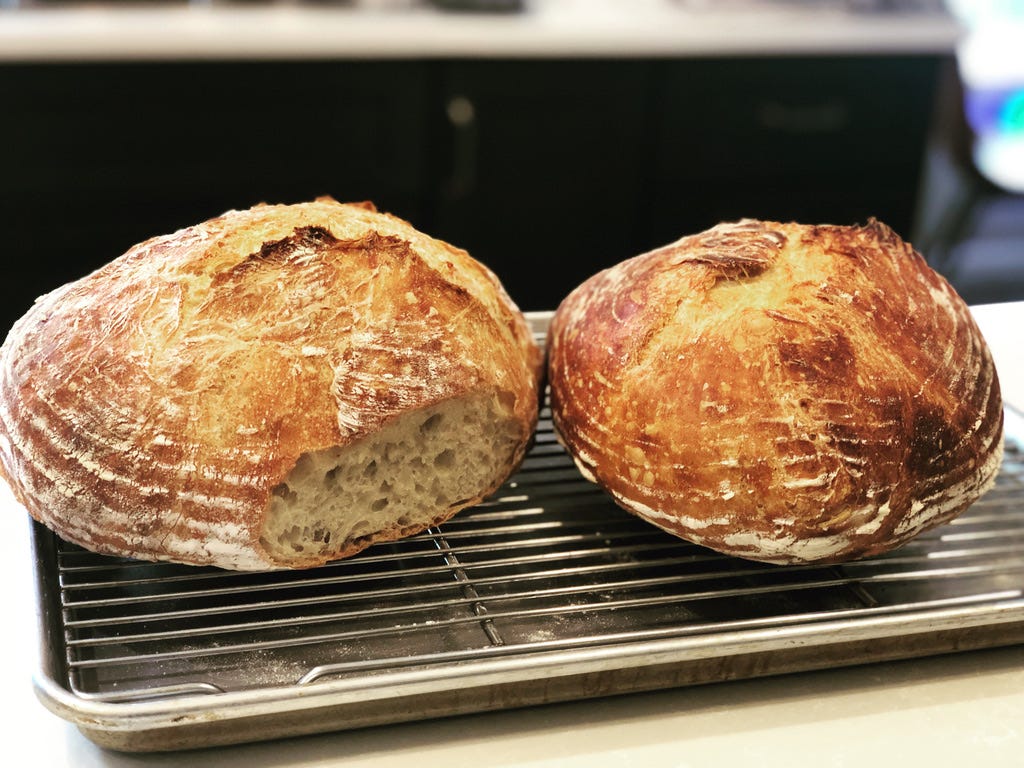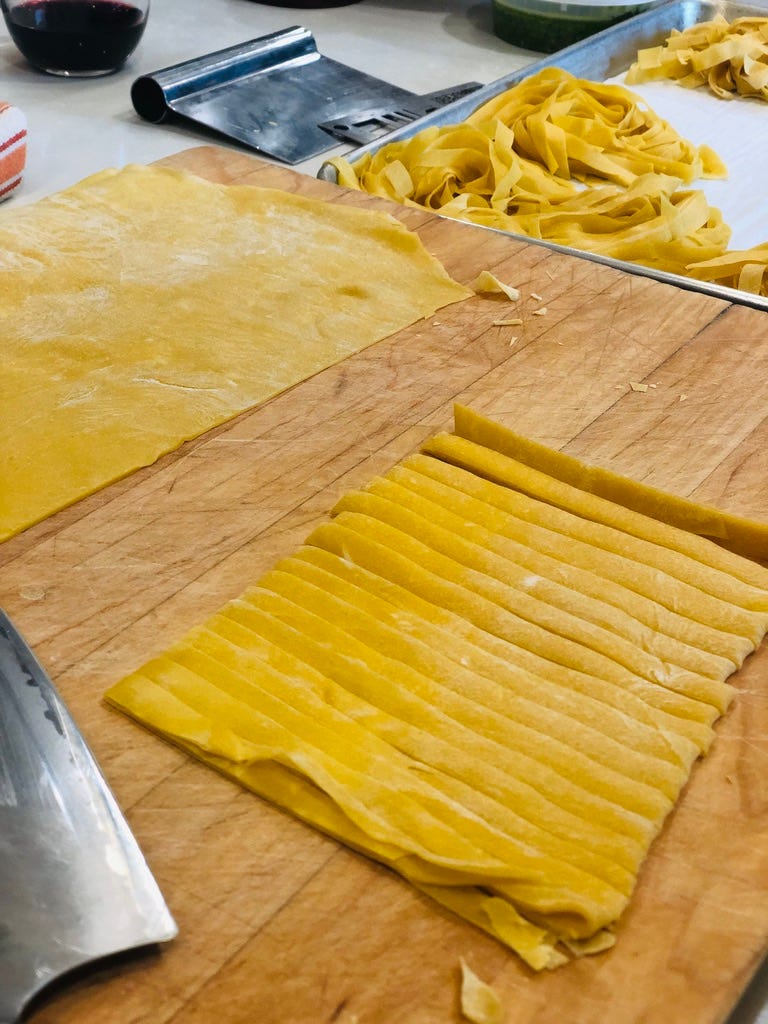Dough
Or is it D'Oh!
Among the many cons perpetrated on the American consumer is the myth that making dough is hard.
Helping us swallow that particular pill is a vast array of easily available alternatives to making and cooking with dough ourselves. Grocery store shelves are lined with dozens of bread brands. You can find a ready-made pie crust in nearly any frozen aisle. And there are both dried and (sometimes) even fresh pasta options to choose from.
Most of it is terrible.
Nearly all the bread and pastry sold in U.S. supermarkets would be illegal to be labeled as such in several European countries. In fact, most of the raw flour in this country is bleached, a process that is flat out illegal in Europe. (Buy organic flour to avoid this).
But hey, what do you expect? In Italy, food is treated with such reverence that a food historian received death threats for suggesting carbonara was first made with Gruyere cheese. Meanwhile in the U.S., we we take our best known culinary contribution to the world — the burger — and happily whore it out by serving it between two donuts.
Grocery stores here don’t sell food. They sell products. The production and packaging of dough-based products in this country are designed from the ground up to maximize profits. The brands behind them focus on how fast can it be made, how long can it keep on shelves, and at what profit margin.
Flavor, nutrition… these things mean nothing to either the manufacturer or the store. To the industrial food complex, you’re not an eater, you’re a consumer… a wallet, not a mouth.
Yet we buy it up because we’ve been convinced that making dough is too hard. You’ve been fooled into thinking that bread, pastry, or pasta can only be made by practitioners of some kind of culinary dark arts whose mysteries take years of training and funny hats to master.
But while that may hold true for making GREAT doughs, making pretty-damn-good dough is actually pretty easy. In fact, turning wheat into dough was the first real act of cooking in our evolution as a species, after cooking meat over a fire.
I guess what I’m saying is that if our Stone Age ancestors wearing animal skins could make a loaf of bread, you and your KitchenAid and GE oven could probably sort it out too.
It all comes down to a simple ratio of readily available and cheap ingredients.
Ratios
For this post, I’ll only dig into the ratios and basic creation of the dough itself. Each dough can be used for multiple purposes. Bread dough can be used to make boules, baguettes, even pizza dough. Pasta dough can be used to make hundreds of different pasta cuts and shapes. Pastry/Pie dough can be uesed for, well… pies, but also tarts and even savory applications like quiche.
But for the sake of length and sanity, today… just the dough.
Bread Dough
5 parts flour : 3 parts water (plus salt and yeast).
First question you’re going to ask is “how much yeast” and I’m going to say “It depends.”
It depends on how fast you want to bake the bread. A teaspoon of yeast will cause a dough to rise far faster than a quarter teaspoon. But the one that takes longer to rise will taste better.
Another way to look at bread dough ratios in particular is using a Baker's Percentage. Using this math, the amount of water you use will always be a percentage of the total amount of flour.
So using the ratio above, 1000 grams of flour (five units of 200 grams) and 600 grams of water (3 units of 200 grams) will result in a dough with 60% hydration, which is a good place to start.
Steps:
Assemble: Combine water and flour only and mix thoroughly into a ragged ball. Let sit for 30 minutes for the flour to fully absorb the moisture. This is called autolyse. (DON’T add the salt yet as it will cause the dough to tighten up and not absorb the water as much.)
Mix: Add the yeast first and mix it in. Then the salt. I don’t like to add them at the same time b/c the salt inhibits the yeast (which is good to control the rising process, but not so good if you kill the yeast)
Fold: Fold the dough three times, once every 20 minutes. To fold, pull the dough into a long narrow rope. Place it on your cutting board and roll one end up like a beach towel. Stretch it out again from the narrow ends and repeat. Like this…
Let it rest for 20 minutes, and do this again. By the third fold, the dough should be smooth and less sticky/tacky.
Bulk Ferment: This is also referred to as the first rise. Just let it sit, covered. Again, how long depends on how much yeast you added. But you want it to double/triple in size.
Shape: Don’t “punch down” on the dough before shaping. Just gently tip it out of the bowl onto a lightly floured board and cut it into the sizes you need. That’s enough “degassing” needed.
Proof: This is called the “second rise.” Just let the bread sit in whatever shape bowl you’re using for an hour.
Pasta Dough
2 parts egg : 3 parts flour
But… that’s only helpful if you have and use a scale (which you really should). So another rule of thumb is to START with: 1 egg to 100 grams flour = 1 serving. Just know that you’ll likely need to add a little flour as you go until it feels right.
Steps
Mix: mound the flour onto a wooden cutting board and use an egg to create a well in the center. The width of the well should be the same as the total # of eggs you’re using (1 egg = 1 egg wide. 2 eggs = 2 eggs wide). Break the eggs into the well and scramble them with a fork, slowly incorporating the flour from the edges.
Fold: continue mixing until the eggs and flour create a thick batter, like pancake batter. Then use a bench scraper to cut in the flour, starting from one side only (ie: left to right). You may not need all the flour, so push away the excess flour on the opposite side from which you’re using the bench scraper. Continue until you have a very wet, shaggy ball.
Knead: Add flour as needed just a little bit at a time and begin slowly kneading the dough. The outside will feel dry and soft, but the inside may feel a bit tacky/sticky. Resist the urge to add more flour and simply knead for about 5 minutes until the tackiness is gone and the dough is dry but soft.
Wrap in foil and let it rest for at least 30 minutes.
Pastry Dough
3 parts flour : 2 parts butter : 1 part water
Both the flour and the butter have to be COLD.
Steps:
Sheeting: Add cubed cold butter into flour and “sheet” the butter into the flour with your fingers. You’re kind of snapping your fingers with the butter into the flour so the turn into thin “sheets” of butter covered in flour.
Water: add the cold water and stir into a mass. Reserve a little water and only add it you feel necessary.
Fold: Don’t knead. Gently fold the dough into layers until it’s all come together. The dough should stick together if squeezed into a ball, but also break in half easily if pulled apart.
Form a round disc, wrap, and let sit in the fridge for at least 30 minutes or until ready to roll/use.
Notes
Scales: Get a kitchen scale that can measure in both U.S. and metric units. While the weight-to-volume ratio is constant with liquids (“a pint is a pound the whole world round”) flour and other solids are not.
Yeast: There are different types of yeast, the most common are Active Dry vs. Instant Yeast. Active Dry is a coated yeast that needs to be “activated” by mixing it with water. Instant Yeast is not coated, and can be added directly to the flour as part of the mixing process. I exclusively use Instant Yeast.
Flour: The difference between Bread Flour, All Purpose (AP) Flour, and 00 flour comes down to protein percentage (and how fine it's ground). The higher the protein content, the tougher (or sturdier) the dough. I use all three, for different things. It’s worth having all in your pantry, so long as the’re organic. It’s one of the few times when organic options actually matter.
Now, these ratios of course are only the start. You may want to use a book/recipe/video for the granular details to turn the dough into something to eat.
But honestly don’t sweat it too much at first. You are almost certainly going to make a lot of mistakes your first few times. It won’t be perfect. But it’ll be edible.
My point here is that these are cheap and readily available ingredients – flour, butter, eggs, salt, yeast. Once you realize that even “wrong” dough is still pretty good, THEN you can work on it with your favorite book or video.
Just try it. These are cheap ingredients. You’re not even losing time, because time spent learning from mistakes is the most productive time you can spend.





Love this Antony! Both the writing and the tips.
Quick question.
You reference rolling the rope of dough like a beach towel. I'm having trouble picturing this. I can only think of one way to roll a rope of dough and that would create a circular shape when laid flat. So that can't be right because the next direction references stretching out from the narrow end, and there wouldn't be one if it's a circle. Help please!